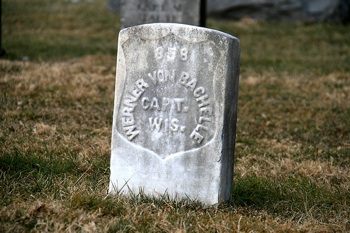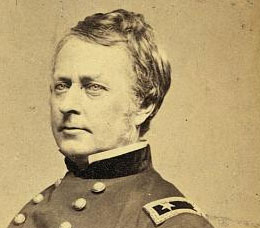The Newf and Werner von Bachelle
9 January 2011

(Janet Richmond, via Flickr)
This is the stone at Antietam National Cemetery for Captain Werner von Bachelle, killed in action on 17 September 1862 at Antietam. He’s something of a celebrity today. School kids hear of him in their packets at the cemetery and battlefield. Though he died a brave soldier, like so many others that day, that’s not why he’s so well known. He owes his celebrity to his dog.
In April 1861 von Bachelle volunteered with his local militia, the Citizens Corps of Milwaukee, for service in response to President Lincoln’s first call for troops. In May the officers – Capt. William Lindwurm, 1st Lt. Frederick Schumacher, and 2nd Lt. Werner Von Bachelle – were commissioned in Federal service and their unit became Company F of the new 6th Regiment of Wisconsin Volunteer Infantry. Like von Bachelle, nearly all of the men of the Company were German speakers, most German born …
The Liljenquist photographs and Sharpsburg
31 December 2010
I have been busy with the business of life, but not entirely ignorant of the world outside! I certainly noticed the October 2010 announcement of the incredible generosity of the Liljenquist family who donated their collection of more than 700 Civil War ambrotypes and tintypes to the Library of Congress. The Library is creating a physical exhibit for them opening in April 2011 as part of the Sesquicentennial observations.
In the meantime, they’ve scanned and posted the collection online on their own pages and through a Flickr photostream. I’ve explored this treasure a little, and found some intriguing images with connections to our favorite battlefield.
![[Unidentified woman wearing mourning brooch and displaying framed image of unidentifed soldier] (LOC)](https://live.staticflickr.com/5201/5228622401_284617d66c.jpg)
Woman wearing mourning brooch and displaying framed image of soldier (1861 – 1865, Library of Congress via Flickr)
I’m sorry that so few of the subjects of these pictures are identified. Only a couple of dozen are named, another dozen or so are identified by military unit from clues on their uniforms or in the photo background. The remaining hundreds are unidentified.
I am moved all the more, however, by the anonymity of this woman in her grief. I presume from the context that the soldier in her lap has recently been killed. Her husband? It reminds me again of the deadly way the War ripped through families and brings perspective to battle maps, memorials and markers …
Dr. Howard and Hooker’s foot
13 February 2010
Because he was conspicuous on his white horse and close to the battle-front on the morning of Wednesday, 17 September 1862 near Sharpsburg, Maryland, perhaps it was inevitable that Major General Joseph Hooker would be killed or wounded in the ferocious combat there.

Major General Joseph Hooker (c. 1862, Library of Congress)
And wounded he was. Although it is fantasy to speculate, there were those who thought the battle of Antietam would have gone differently had Hooker not been knocked from command of the Federal First (I) Army Corps by a bullet through the foot at about nine o’clock that morning.
Sharpsburg, September 20, 1862.
MY DEAR HOOKER: I have been very sick the last few days, and just able to go where my presence was absolutely necessary, so I could not come to see you and thank you for what you did the other day, and express my intense regret and sympathy for your unfortunate wound. Had you not been wounded when you were, I believe the result of the battle would have been the entire destruction of the rebel army, for I know that, with you at its head, your corps would have kept on until it gained the main road. As a slight expression of what I think you merit. I have requested that the brigadier-general commission rendered vacant by Mansfield’s death may be given to you. I will this evening write a private note to the President on the subject, and I am glad to assure you that, so far as I can learn, it is the universal feeling of the army that are the most deserving in it.
With the sincere hope that your health may soon be restored, so that you may again be with us in the field, I am, my dear general, your sincere friend,
GEO. B. McCLELLAN,
Major-General.
Looking into the nature of the General’s injury led me in a somewhat different direction, however – toward learning about the medical care he received, and more about the life and career of his doctor, Assistant Surgeon Benjamin Douglas Howard, USA …
